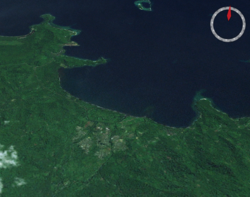This article needs additional citations for verification .(October 2019) |
Arawa | |
|---|---|
Town | |
 The city of Arawa, and the port of Kieta, from space | |
| Coordinates: 6°13′30″S155°34′00″E / 6.22500°S 155.56667°E | |
| Country | |
| Province | Autonomous Region of Bougainville |
| District | Central Bougainville |
| LLG | Arawa Rural LLG |
| Established | 1884 |
| Population (2000) | |
• Total | 36,443 |
| • Rank | 4th |
| Languages | |
| • Main languages | English, Tok Pisin |
| • Traditional language | Naasioi |
| Time zone | UTC+11 (BST) |
| Location | 22 km (14 mi) from Panguna |
| Mean max temp | 32 °C (90 °F) |
| Mean min temp | 23 °C (73 °F) |
| Annual rainfall | 3,037 mm (119.6 in) |
| Climate | Af |
Arawa is the largest town and the former capital of the Autonomous Region of Bougainville in Papua New Guinea. It is administered under Arawa Rural LLG. [1]
Contents
The town was largely destroyed during the Bougainville Civil War,[ citation needed ] resulting in the relocation of the capital to Buka, though there are plans to rebuild Arawa and make it the capital again. [2] The land where Arawa is now situated was previously a large expatriate plantation.
